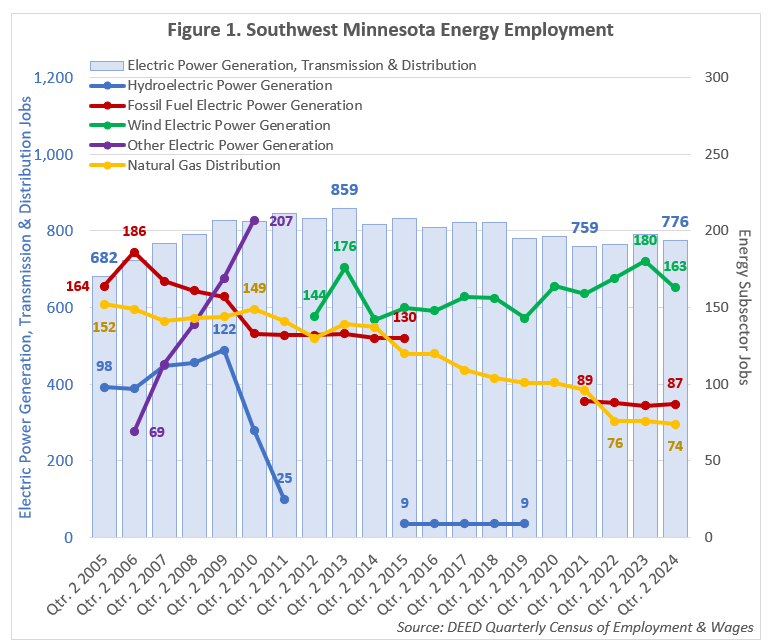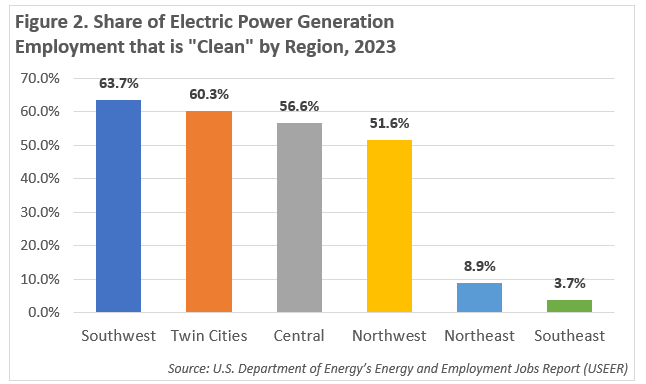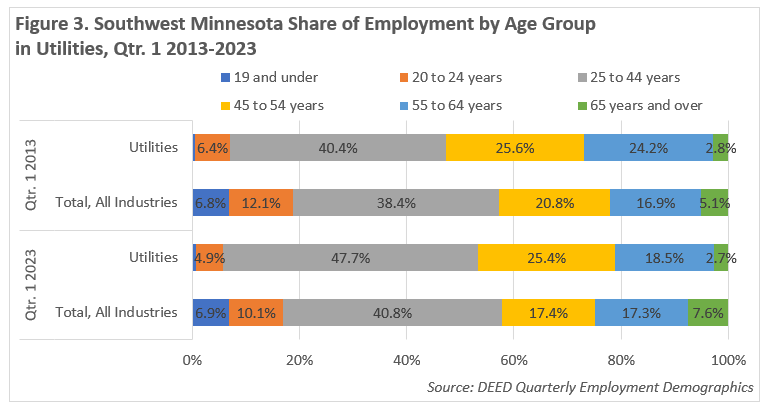 Southwest Minnesota is a national leader in agricultural production, and renewable energy.
Southwest Minnesota is a national leader in agricultural production, and renewable energy.
The region's thriving manufacturing sector includes food processing, machinery, printing, metal products, and computers and electronic products.
Want the freshest data delivered by email? Subscribe to our regional newsletters.
1/31/2025 1:42:47 PM
Luke Greiner, Amanda Blaschko
Southwest Minnesota is a region with significant potential for renewable energy generation, thanks to its vast open spaces and favorable environmental conditions. Over the years, the region has witnessed significant shifts in energy production and clean energy contributions, most notably in Wind Energy. Over the past two decades, regional employment in Electric Power Generation, Transmission and Distribution has increased by almost 100 jobs.
With 50 establishments providing about 775 jobs through the second quarter of 2024, Electric Power Generation, Transmission and Distribution is a small but critical industry in Southwest Minnesota, including both the more traditional Fossil Fuel Electric Power Generation and the emerging Wind Electric Power Generation subsectors. Well known for the Buffalo Ridge, Wind Electric Power Generation has nearly doubled up Fossil Fuel Electric Power Generation in total employment in the region, averaging around 165 jobs compared to less than 90 jobs in the latter, including coal, which has dropped from over 180 jobs back in 2006 (see Figure 1).

The region also has eight firms operating in Natural Gas Distribution, providing about 75 jobs in 2024, which was also less than half of what it had 20 years ago. After peaking with 122 jobs in the second quarter of 2009, the region's employment in Hydroelectric Power Generation trickled down to just 9 jobs between 2015 and 2019, and is no longer a source of notable employment in the region. This shows the region's transition from traditional energy generation to new sources.
In fact, looking at energy employment numbers from the U.S. Department of Energy's Energy and Employment Jobs Report (referred to as USEER), Southwest Minnesota has the highest share of electric power generation employment that is "Clean." The region's high and growing concentration of employment in wind puts it at the forefront of clean energy employment in the state (Figure 2).

With average annual wages above $107,000 in 2023, Electric Power Generation, Transmission and Distribution is one of the highest paying industries in the region; more than double the average annual wage across the total of all industries, which was $52,520. These high wage Utilities jobs line up with a prime age workforce, where nearly half (47.7%) of jobholders in Utilities are 25 to 44 years of age, compared to about 41% in the total of all industries. According to data from DEED's /deed/data/data-tools/qed/index.jspQuarterly Employment Demographics (QED) program, Utilities also tend to have a larger reliance on older workers, with another 47% of jobholders aged 45 years and older, compared to 42.3% across all industries in 2023.
The Utilities workforce is also unique at the far ends of the age spectrum – less than 1.0% of jobholders in Utilities were teenagers, compared to almost 7% overall, which is likely a reflection of the skill, education, and physical requirements for workers in the industry. Conversely, just 2.7% of jobholders in Utilities were 65 years and over, compared to 7.6% across all industries. This is likely also a function of the physical requirements, as well as high wages and retirement opportunities in the industry. Interestingly, while the share of workers in the oldest age group has been increasing across all industries over the past 10 years, it dropped slightly in Utilities (Figure 3).

QED data also show another workforce difference in Utilities compared to the total of all industries. While overall employment is split pretty evenly between males and females, jobholders in Utilities are overwhelmingly male, with men holding 79% of jobs and women holding just 21% in 2023. What's more, that number has held mostly steady over the past 10 years which presents a huge opportunity for nontraditional workers.
DEED LMI researcher Molly Ingram is writing a series of articles in Minnesota Economic Trends on our state's green and clean economy. So far, her articles have covered /deed/newscenter/publications/trends/june-2024/green.jspdefinitions and counts of jobs by green industries, /deed/newscenter/publications/trends/september-2024/green-clean.jspemployment by occupation, and in the December issue, /deed/newscenter/publications/trends/december-2024/index.jspregional data, employment trends, and future workforce demand. As terminology and data are refined and greater consensus is reached, we will have an increasingly accurate picture of the local employment impacts from the energy transition. We also recommend visiting DEED's Energy Transition Office website, which is tasked with helping communities as they continue to move away from fossil fuels.
For more information about energy sector employment in Southwest Minnesota, contact Luke Greiner at luke.greiner@state.mn.us or Amanda Blaschko at amanda.blaschko@state.mn.us or visit CareerForceMN's Find a Job.